The Intel Core i7-7700K (91W) Review: The New Out-of-the-box Performance Champion
by Ian Cutress on January 3, 2017 12:02 PM ESTOffice Performance
The dynamics of CPU Turbo modes, both Intel and AMD, can cause concern during environments with a variable threaded workload. There is also an added issue of the motherboard remaining consistent, depending on how the motherboard manufacturer wants to add in their own boosting technologies over the ones that Intel would prefer they used. In order to remain consistent, we implement an OS-level unique high performance mode on all the CPUs we test which should override any motherboard manufacturer performance mode.
All of our benchmark results can also be found in our benchmark engine, Bench.
Dolphin Benchmark: link
Many emulators are often bound by single thread CPU performance, and general reports tended to suggest that Haswell provided a significant boost to emulator performance. This benchmark runs a Wii program that raytraces a complex 3D scene inside the Dolphin Wii emulator. Performance on this benchmark is a good proxy of the speed of Dolphin CPU emulation, which is an intensive single core task using most aspects of a CPU. Results are given in minutes, where the Wii itself scores 17.53 minutes.
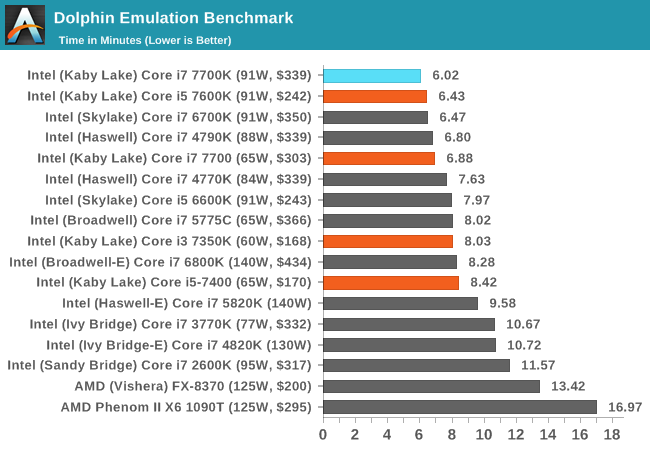
As shown by the data, the i7-7700K takes the top spot. At stock it edges out an overclocked Core i7-4790K at 4.7 GHz, which is no mean feat. Dolphin is all about high frequency and IPC, which the i7-7700K has the best of both.
WinRAR 5.0.1: link
Our WinRAR test from 2013 is updated to the latest version of WinRAR at the start of 2014. We compress a set of 2867 files across 320 folders totaling 1.52 GB in size – 95% of these files are small typical website files, and the rest (90% of the size) are small 30 second 720p videos.
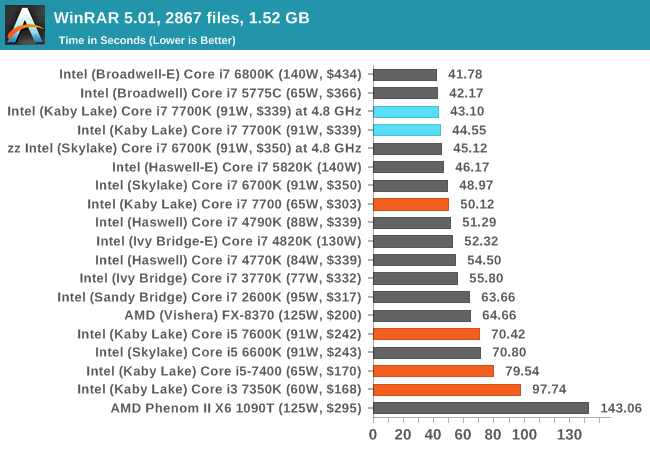
WinRAR is more geared towards a variable threaded environment but also memory speed. While two channels of DDR4-2400 does well for the Core i7-7700K, to the point where it beats the 6-core i7-5930K, anything with eDRAM (i7-5775C) and the higher end quad channel processors with up to 10 cores do win out. But at $1700 for 10-core, the Kaby Lake CPU does well – the only processor that beats it in its price range is that eDRAM-based i7 part.
3D Particle Movement v2
3DPM is a self-penned benchmark, taking basic 3D movement algorithms used in Brownian Motion simulations and testing them for speed. High floating point performance, MHz and IPC wins the day. This is the second variant of this benchmark, fixing for false sharing in the first version, and lending itself to better multithreaded performance.
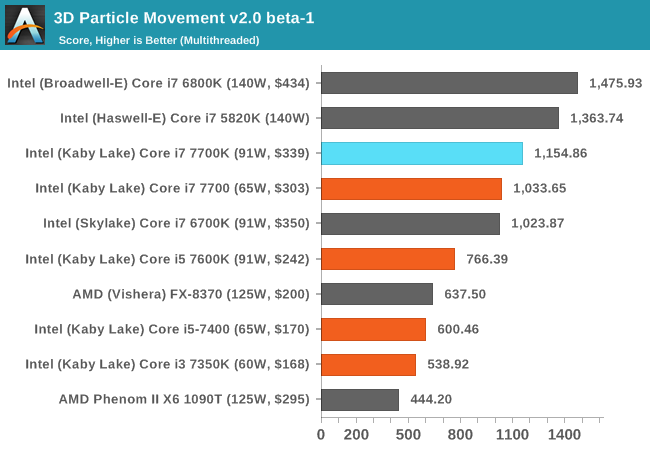
3DPMv2 is still new, so we don’t have too many results for it so far, but it hits the top of the mainstream processor stack as was perhaps to be expected. It scores almost double an FX-8370, showing how far Intel’s mainstream has come from AMD’s old CPUs, but the Core i7-7700K matches up to just over double the Core i3-7350K, as it has double the cores/threads and slightly more frequency.
SYSMark 2014
Engineered by BAPco (to which Intel is a consortium member), this set of tests are designed to be an office/data/media/financial range of tests using common well-known CAD, image editing, web browsing and other tools to put out a score, where a score of 1000 is attributed to an old Core i3 using a mechanical harddrive. Here we report the overall score, however the test breakdowns can be found in Bench.

Because SYSMark is a variety of tests that rely on response and throughput, the Core i7-7700K hits the mix just right and scores higher than even a 10-core Core i7 Extreme part launched last year, as well as a highly overclocked Devil’s Canyon. Aside from the Core i5, the 7700K does well in price/performance here.
Web Benchmarks
On the lower end processors, general usability is a big factor of experience, especially as we move into the HTML5 era of web browsing. For our web benchmarks, we take well known tests with Chrome as installed by SYSMark as a consistent browser.
Mozilla Kraken 1.1
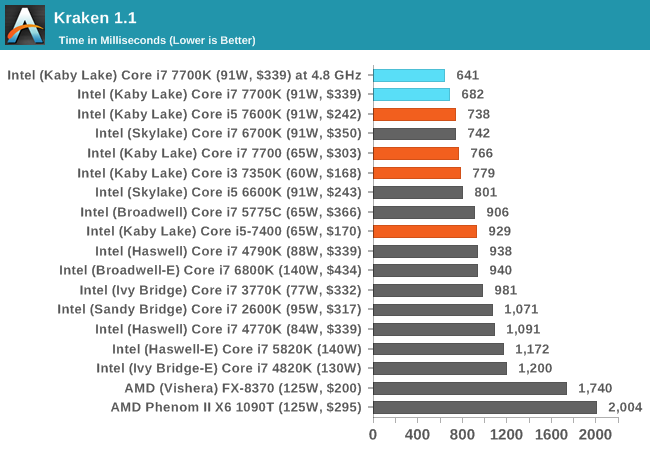
Google Octane v2
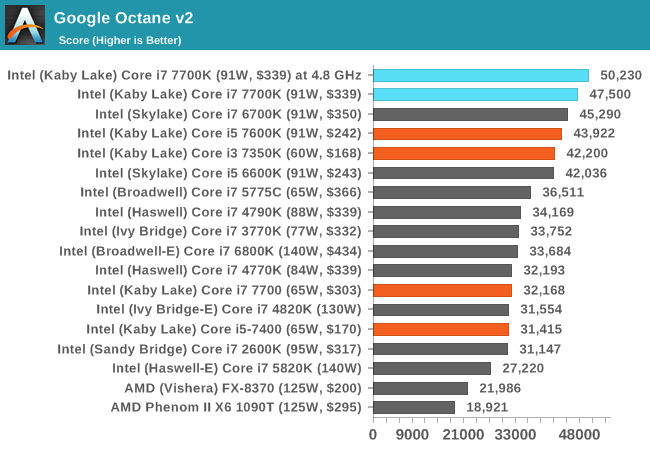










125 Comments
View All Comments
Jason335 - Saturday, January 7, 2017 - link
I'm really looking forward to this: "Calculating Generational IPC Changes from Sandy Bridge to Kaby Lake". I'm still running an i5-2500k clocked to 4.3ghz. I'd like to know what performance I'm leaving on the table, in addition to new tech like USB3.1, PCIe3.0, NVME, etc etc etc.cheshirster - Sunday, January 8, 2017 - link
Windows 7 and old games.These tests start to look outdated.
HerrKaLeun - Sunday, January 8, 2017 - link
to all the people whining about the relatively small increase in performance: this is expected with an interim upgrade. Intel never promised more. Intel (or AMD) doesn't owe you anything. If you think you can make better CPUs and upgrade faster, just make them. no one stops you from creating a startup and make your own CPUs :-)no one in his or her right mind would buy the same CPU (i.e. going from 6700 to 7700) and expect a huge increase. This has been a known fact for years that upgrading is worthwhile after a few years.
I just installed an i7 7700K in my rig (it replaces an i36600) and the bump is huge. At given handbrake settings I now can encode 3 instances of videos and each video takes 2-3 hours while with the i3 a single instance took 12-16 hours (i use slowest speeds to get the smallest and best video file and quality). To me the upgrade was worth the money (obviously going from i3 to i7 is noticeable when using multi-threaded apps).
I was contemplating of getting the i5K for $100 less, but decided more threads, more cache and more clock is great.
BTW, even when using all cores clock is at 4.33 GHz consistently, not the 4.2 GHz i though if it uses all cores. It jumps to 4.37 every once a while while working on the 3 Handbrake instances. Most reviews measure single apps, but in real life you use the PC while it works. Just using browser, watching web videos etc. adds more load that is not reflected in benchmarks. the added power really is good. With the i3 chrome or my game sometimes took 20-30% of my CPU, which slowed Handbrake noticeably down. Now those apps use not more than 5% if at all. So in real life the HT seems to help more.
this review was great, like most of Anand's. Ian does a really great job. To all the people complaining about the article:
- it was free to read
- no one forced you to read it
- you could apply to become a writer and write better articles. but soemhow it seems easier to just complain....
HerrKaLeun - Sunday, January 8, 2017 - link
this needs an edit function: I do not OC (only have an H170 board). above clock speed is out of the box.coachingjoy - Monday, January 9, 2017 - link
Thanks for the work.Helps with buying decisions.
ewags - Friday, January 13, 2017 - link
Great review, I will need to see if I can get my CPU over 5.2ghz Stable with a few tweaks that you did.Infkos - Saturday, January 14, 2017 - link
no one talks about temps problems with 7700K, only works on water coolingfanofanand - Thursday, January 26, 2017 - link
'only works on water cooling"GTFO troll.
theVatansever - Tuesday, January 17, 2017 - link
I think i'm the lucky one,,,without AVX offset, i'm perfectly stable at 4 cores @5000mhz @1,34V ....1.5hrs of prime95 torture test without any issue, max temp seen is 81C with liquid cooler.(average temps are around 72C)hapkiman - Saturday, January 21, 2017 - link
After an opportunity dropped in my lap to get this processor for next to nothing, I got it and installed it on an MSI Z170A mobo (after a BIOS update). I'm very impressed. This is a nice processor, and an outstanding overclocker. Without even touching the voltage, I went to 4.8GHz without a sweat. With tasking and voltage adjustment, I see 5GHz is attainable. Maybe this is the new Sandy Bridge? My 6700k could not even maintain a stable 4.7GHz.